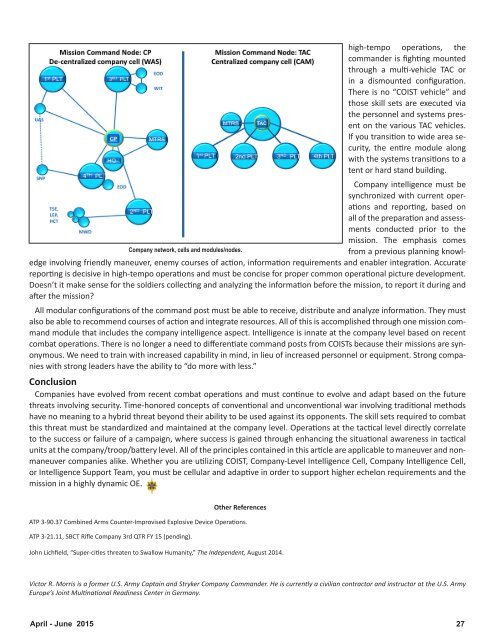incorrect
2015_02
2015_02
- No tags were found...
Create successful ePaper yourself
Turn your PDF publications into a flip-book with our unique Google optimized e-Paper software.
high-tempo operations, the<br />
commander is fighting mounted<br />
through a multi-vehicle TAC or<br />
in a dismounted configuration.<br />
There is no “COIST vehicle” and<br />
those skill sets are executed via<br />
the personnel and systems present<br />
on the various TAC vehicles.<br />
If you transition to wide area security,<br />
the entire module along<br />
with the systems transitions to a<br />
tent or hard stand building.<br />
Company intelligence must be<br />
synchronized with current operations<br />
and reporting, based on<br />
all of the preparation and assessments<br />
conducted prior to the<br />
mission. The emphasis comes<br />
Company network, cells and modules/nodes.<br />
from a previous planning knowledge<br />
involving friendly maneuver, enemy courses of action, information requirements and enabler integration. Accurate<br />
reporting is decisive in high-tempo operations and must be concise for proper common operational picture development.<br />
Doesn’t it make sense for the soldiers collecting and analyzing the information before the mission, to report it during and<br />
after the mission?<br />
All modular configurations of the command post must be able to receive, distribute and analyze information. They must<br />
also be able to recommend courses of action and integrate resources. All of this is accomplished through one mission command<br />
module that includes the company intelligence aspect. Intelligence is innate at the company level based on recent<br />
combat operations. There is no longer a need to differentiate command posts from COISTs because their missions are synonymous.<br />
We need to train with increased capability in mind, in lieu of increased personnel or equipment. Strong companies<br />
with strong leaders have the ability to “do more with less.”<br />
Conclusion<br />
Companies have evolved from recent combat operations and must continue to evolve and adapt based on the future<br />
threats involving security. Time-honored concepts of conventional and unconventional war involving traditional methods<br />
have no meaning to a hybrid threat beyond their ability to be used against its opponents. The skill sets required to combat<br />
this threat must be standardized and maintained at the company level. Operations at the tactical level directly correlate<br />
to the success or failure of a campaign, where success is gained through enhancing the situational awareness in tactical<br />
units at the company/troop/battery level. All of the principles contained in this article are applicable to maneuver and nonmaneuver<br />
companies alike. Whether you are utilizing COIST, Company-Level Intelligence Cell, Company Intelligence Cell,<br />
or Intelligence Support Team, you must be cellular and adaptive in order to support higher echelon requirements and the<br />
mission in a highly dynamic OE.<br />
Other References<br />
ATP 3-90.37 Combined Arms Counter-Improvised Explosive Device Operations.<br />
ATP 3-21.11, SBCT Rifle Company 3rd QTR FY 15 (pending).<br />
John Lichfield, “Super-cities threaten to Swallow Humanity,” The Independent, August 2014.<br />
Victor R. Morris is a former U.S. Army Captain and Stryker Company Commander. He is currently a civilian contractor and instructor at the U.S. Army<br />
Europe’s Joint Multinational Readiness Center in Germany.<br />
April - June 2015<br />
27


